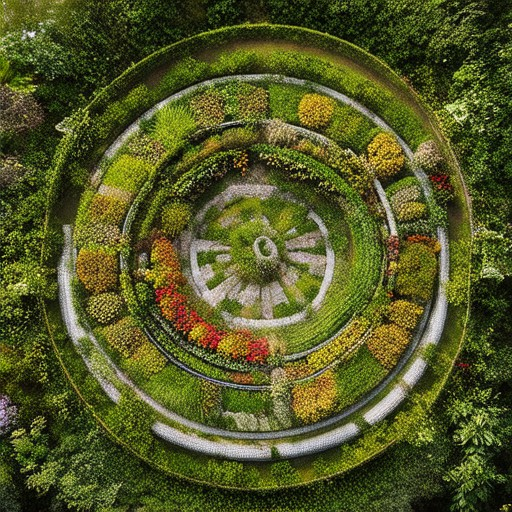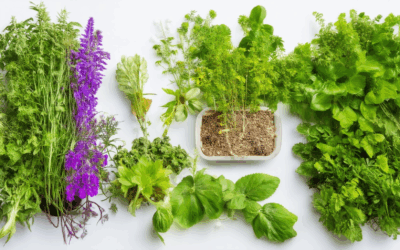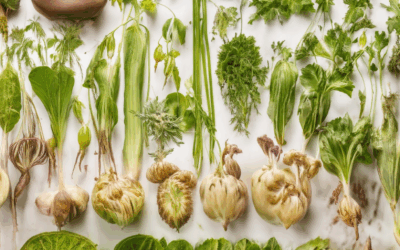Permaculture gardening has emerged as a popular and eco-friendly approach to sustainable living, offering a unique way to design and maintain a thriving garden space. For those new to the concept, permaculture gardens are designed to mimic natural ecosystems, promoting biodiversity and reducing the need for external inputs such as pesticides and fertilizers. However, achieving a balanced and productive permaculture garden requires careful planning, from selecting the right plants to optimizing space and resources. In this comprehensive guide, we will explore the essential steps, layouts, and key elements involved in planning a successful permaculture garden, ensuring your efforts yield abundant results while benefiting the environment. Whether you’re a seasoned gardener or just beginning, this article will provide valuable insights and practical tips to help you create a permaculture garden that thrives for years to come.
Key Takeaways
– Evaluate Your Site: Assess your property’s conditions, including soil type, sun exposure, water availability, and microclimates, to choose plants suited to your area’s climate and soil.
– Select Native Plants: Opt for native plants to enhance biodiversity, reduce maintenance, and support local wildlife.
– Design a Guild Layout: Create guilds of plants that work together, including nitrogen fixers, pollinator attractors, and edible plants, to maximize biodiversity and efficiency.
– Implement Water Management: Capture and store rainwater using techniques like swales and drip irrigation to minimize external water reliance.
– Enhance Soil Health: Improve soil structure, fertility, and moisture retention with compost, mulch, and organic matter.
– Practice Natural Pest Control: Attract beneficial insects and animals, and use companion planting and crop rotation to manage pests effectively.
– Promote Biodiversity: Plant a variety of species to support pollinators and wildlife, creating a self-sustaining ecosystem.
– Ensure Easy Navigation: Design pathways and structures for accessibility and enjoyment, using stepping stones and clear signage.
– Attract Wildlife and Manage Pests: Incorporate nesting areas and flowers for pollinators, and use natural methods to control pests.
– Plan for Succession Planting: Extend the growing season and ensure continuous harvest through regular observations and adjustments.
– Utilize Local Resources: Make the most of rainwater, compostable materials, and natural pest controls to promote sustainability.
– Focus on Long-Term Sustainability: Plant long-lived trees, shrubs, and perennials for future generations.
– Integrate Functional and Aesthetic Elements: Design curved beds, windbreaks, and inviting pathways for both beauty and functionality.
– Prioritize Soil Health: Regularly amend soil with organic matter, practice cover cropping, and use compost for improved fertility and structure.
– Create Polycultures and Guilds: Group plants together based on their functions and needs to create self-sustaining systems.
– Explore Resources: Visit Old Seed for detailed guides and insights tailored to eco-conscious gardeners.
Essential Steps for Planning a Successful Permaculture Garden
To establish a thriving permaculture garden, follow these organized steps:
- Assess Your Site Conditions
- Observe the sunlight exposure, water availability, and microclimates.
- Test the soil pH and nutrient levels to ensure optimal plant growth.
- Evaluate existing structures and plants to integrate them harmoniously.
- Choose native plants suited to your region for maximum adaptability.
- Research and select plants that form effective guilds, enhancing biodiversity and sustainability.
- Purchase from reputable nurseries or consult local resources for recommendations.
- Plan layers of plants including trees, shrubs, herbs, vegetables, and ground cover.
- Consider circular or spiral designs to optimize space and promote biodiversity.
- Position fruit trees and berries centrally for easy access and maximum benefit.
- Apply mulch to conserve water and suppress weeds.
- Set up a compost system using kitchen scraps and yard waste.
- Add worm castings as a natural fertilizer once your system is established.
- Incorporate flowers and nesting areas for pollinators and wildlife.
- Practice crop rotation and use natural predators to manage pests.
- Consider integrating farm animals for organic pest control and manure production.
- Monitor plant health, water needs, and pest activity regularly.
- Document successes and challenges to refine your approach over time.
- Succession planting extends the growing season and ensures continuous harvest.
For detailed guidance, explore resources from trusted permaculture experts like Old Seed , which offers comprehensive guides and insights tailored to eco-conscious gardeners.
What Are the Key Considerations When Designing a Permaculture Garden Layout?
When designing a permaculture garden layout, several key factors come into play to ensure productivity, sustainability, and harmony with the environment. Here’s a breakdown of the most important considerations:
- Site Selection
- Climate and Microclimate: Assess the local climate, including temperature patterns, rainfall, and humidity. Choose a spot that mimics the natural conditions of the plants you wish to grow. Also, consider microclimates within your yard that may offer different growing conditions due to variations in sunlight, wind, and elevation.
- Aspect and Sun Exposure: Select a location that receives the optimal amount of sunlight for your crops. North-facing slopes are ideal for cool-climate crops, while south-facing areas work better for warm-climate plants.
- Existing Structures: Avoid placing your garden near buildings, fences, or trees that might block sunlight or introduce pests. Also, steer clear of areas prone to erosion or flooding.
- Choosing the Right Spot: Make sure the area is accessible for planting, harvesting, and maintenance while maximizing space efficiency.
- Soil Health
- Testing and Preparation: Conduct a soil test to determine pH levels, nutrient content, and organic matter. Most plants thrive in slightly acidic to neutral soil (6.0–8.0 pH), but some crops prefer specific conditions.
- Organic Matter and Amendments: Incorporate compost, manure, or worm castings to improve soil fertility and structure. Consider applying mulch to retain moisture and suppress weeds.
- Drainage and Water Retention: Ensure the soil has proper drainage to prevent waterlogging, which can lead to root rot. On the other hand, certain plants thrive in wetter environments, so choose your site accordingly.
- Sustainable Practices
- Mulching and Composting: Apply thick layers of mulch to regulate soil temperature, conserve moisture, and reduce weed growth. Regularly add compost to maintain soil health and nutrients.
- Water Conservation: Implement drip irrigation or rainwater harvesting systems to minimize water usage. Permaculture gardens often rely on natural precipitation and efficient watering techniques.
- Crop Rotation and Succession: Plant a variety of crops in different seasons to maintain soil balance and prevent pests. Successive planting ensures that the garden remains productive year-round.
- Biodiversity: Incorporate native plants, pollinator-attracting flowers, and beneficial insects to create a self-sustaining ecosystem that supports your main crops.
By thoughtfully considering these factors, you can design a permaculture garden layout that thrives on natural processes and provides long-term benefits for both your garden and the environment.
Key Elements Involved in Planning a Permaculture Garden
Permaculture gardening is an eco-friendly approach that focuses on sustainability, biodiversity, and harmony with nature. To effectively plan a permaculture garden, consider the following key elements:
- Site Assessment : Begin by evaluating your garden’s site conditions. Assess sunlight exposure, soil quality, and water access. Measure microclimates using tools like thermometers to identify shaded areas and understand where the sun hits strongest. Test soil pH levels to determine nutrient deficiencies and amend accordingly.
- Plant Selection : Choose plants suited to your climate and growing season. Incorporate a mix of annuals, perennials, and edibles. Consult local gardening forums or resources to identify plants that thrive in your region and during your growing season.
- Layout Design : Design your garden by creating zones for different plant types, such as edible crops, nitrogen fixers, and pollinator-attracting plants. Consider incorporating swales for water retention and pathways for easy navigation. Sketch your design to visualize the layout effectively.
- Planting Schedule : Develop a planting schedule tailored to each plant’s needs. Decide between sowing seeds or using transplants, adjusting the timeline based on your region’s climate. Create a monthly calendar to track planting tasks and monitor growth.
- Sustainability Practices : Implement regular maintenance practices like mulching to retain moisture and suppress weeds, and composting to enrich your soil. Explore options like worm composting for efficient waste management.
- Adaptability : Stay flexible and observe your garden’s progress. Adapt to challenges like pests, diseases, and weather changes by rotating crops and learning from seasonal variations.
For further guidance, visit Old Seed to explore their comprehensive gardening resources and learn more about permaculture techniques tailored to your needs.
What Are the Essential Elements Needed for Effective Permaculture Garden Planning?
Planning an effective permaculture garden requires careful consideration of several key factors to ensure productivity, sustainability, and harmony with the environment. Here are the essential elements:
- Evaluate Your Site
- Select Native Plants
- Design a Guild Layout
- Implement Water Management
- Enhance Soil Health
- Practice Natural Pest Control
- Promote Biodiversity
- Ensure Easy Navigation
Assess your property’s conditions, including soil type, sun exposure, water availability, and microclimates. Choose plants suited to your area’s climate and soil.
Native plants are well-adapted to local conditions, requiring less maintenance and supporting local wildlife. They also enhance biodiversity and reduce the need for external inputs.
A guild is a group of plants that work together, providing mutual benefits. Plan guilds based on functional groups like nitrogen fixers, pollinator attractors, and edible plants.
Effective water management involves rainwater harvesting, swales, and drip irrigation. Capture and store rainwater to minimize reliance on external water sources.
Healthy soil is the foundation of a successful garden. Incorporate compost, mulch, and organic matter to improve soil structure, fertility, and moisture retention.
Encourage beneficial insects, birds, and animals to control pests naturally. Rotate crops and use companion planting to disrupt pest cycles.
Plant a variety of species to support pollinators and other wildlife. This creates a self-sustaining ecosystem that thrives with minimal intervention.
Design pathways and structures to make the garden accessible and enjoyable. Use stepping stones, raised beds, and clear signs to guide movement.
By integrating these elements, you can create a permaculture garden that is both productive and environmentally friendly. For further insights and resources, visit Old Seed , where you can find comprehensive guides and tips tailored to eco-conscious gardeners.
Essential Steps for Planning a Successful Permaculture Garden
To establish a thriving permaculture garden, follow these organized steps:
- Assess Your Site Conditions
- Observe the sunlight exposure, water availability, and microclimates.
- Test the soil pH and nutrient levels to ensure optimal plant growth.
- Evaluate existing structures and plants to integrate them harmoniously.
- Choose native plants suited to your region for maximum adaptability.
- Research and select plants that form effective guilds, enhancing biodiversity and sustainability.
- Purchase from reputable nurseries or consult local resources for recommendations.
- Plan layers of plants including trees, shrubs, herbs, vegetables, and ground cover.
- Consider circular or spiral designs to optimize space and promote biodiversity.
- Position fruit trees and berries centrally for easy access and maximum benefit.
- Apply mulch to conserve water and suppress weeds.
- Set up a compost system using kitchen scraps and yard waste.
- Add worm castings as a natural fertilizer once your system is established.
- Incorporate flowers and nesting areas for pollinators and wildlife.
- Practice crop rotation and use natural predators to manage pests.
- Consider integrating farm animals for organic pest control and manure production.
- Monitor plant health, water needs, and pest activity regularly.
- Document successes and challenges to refine your approach over time.
- Succession planting extends the growing season and ensures continuous harvest.
For detailed guidance, explore resources from trusted permaculture experts like Old Seed , which offers comprehensive guides and insights tailored to eco-conscious gardeners.
Key Principles Behind Creating an Effective Permaculture Garden Plan
Permaculture gardening is a sustainable and eco-friendly approach to growing food and plants. To create an effective permaculture garden plan, consider the following key principles:
- Observe and Mimic Natural Systems : Study the natural environment around your garden to design a plan that mirrors local ecosystems. This includes understanding microclimates, native plant species, and natural water sources.
- Utilize Local Resources : Make the most of what’s already present in your area, such as rainwater, compostable materials, and natural pest controls. This reduces reliance on external inputs and promotes sustainability.
- Design for Biodiversity : Incorporate a variety of plants, insects, and animals to create a balanced ecosystem. This helps attract pollinators and other beneficial organisms that enhance garden productivity.
- Plan for Long-Term Sustainability : Consider the needs of future generations by planting long-lived trees, shrubs, and perennials. This ensures your garden remains productive and ecologically sound for years to come.
- Integrate Functional and Aesthetic Elements : Create a garden that is both beautiful and practical. Use curved beds, windbreaks, and inviting pathways to enhance functionality while maintaining visual appeal.
- Focus on Soil Health : Healthy soil is the foundation of any successful garden. Regularly amend the soil with organic matter, practice cover cropping, and use compost to improve fertility and structure.
- Implement Water Management Strategies : Capture and store rainwater using techniques like swales, rain barrels, and drip irrigation systems. This reduces the need for conventional watering methods.
- Create Guilds and Polycultures : Group plants together based on their functions and needs. For example, companion planting tomatoes with basil and marigolds creates a self-sustaining system that repels pests and attracts pollinators.
By integrating these principles into your permaculture garden plan, you can create a thriving, sustainable space that benefits both the environment and your family. Explore more resources on Old Seed to discover practical tips and detailed guides for successful permaculture gardening.








0 Comments